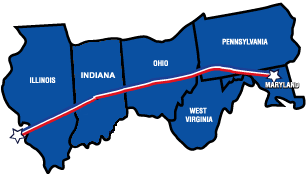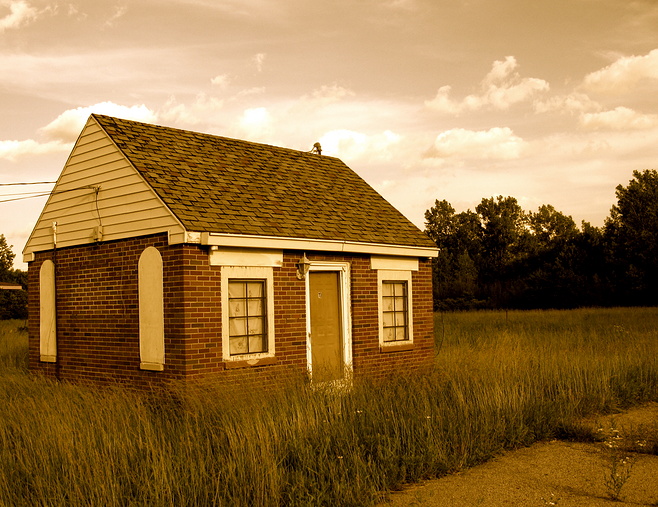|
|
The
National Road The first road in Indiana to run East and West
By 1824 there were four delivery wagons that ran from Indianapolis and Corydon. These wagons carried products and supplies between the two cities. There was also a passenger stagecoach that carried people to the new state capital. Indiana still lacked a passable road system. There were few roads leading to and from Indianapolis. One of the first roads in Indiana was called the Buffalo Trace. This was a former bison trail that connected the cities of New Albany and Vincennes. In 1829 the National Road reached Indiana. No road in American history has played a greater role in opening up the country than what's known today as The Historic National Road. The National Road or Cumberland Road was one of the first major improved highways in the United States, built by the federal government. Construction began in 1811 at Cumberland, Maryland, on the Potomac River. The National Road was later named U.S. Highway 40 when it was made a U.S. highway in 1926-27. Due to the perceived superiority of water travel, the proposed road was seen primarily as a portage between waterways. The western terminus of the National Road at its greatest extent was at the Kaskasia River in Vandalia, Illinois, near the intersection of modern US 51 and US 40. The road proceeded east along modern US 40 through south central Illinois. The National Road continued into Indiana along modern US 40, passing by the cities of Terre Haute and Indianapolis. Within Indianapolis, the National Road used the original alignment of US 40 along modern day West Washington and East Washington streets (modern US 40 is now routed along I-465). East of Indianapolis, the road went through the city of Richmond before entering the state of Ohio. Despite US 40 predominantly following the originally route, many segments of the original road can still be found. Between Old Washington and Morristown, the original roadbed has been overlaid by I-70. The road then continued east across the Ohio River into Wheeling in West Virginia. On April 1, 1835 the section east of Wheeling was transferred to the states, which made it a turnpike. The last Congressional appropriation was made May 25, 1838, and in 1840 Congress voted against completing the road, with the deciding vote cast by Henry Clay. By that time railroads were proving a better method of transportation; the Baltimore and Ohio Railroad was being built for the same purpose - connecting Baltimore via Cumberland to Wheeling. Construction stopped in 1839, and much of the road through Indiana and Illinois remained unfinished, later transferred to the states. In 1912 the National Road was chosen to become part of the National Old Trails Road, which would extend further east to New York City and west to San Francisco, California. Five Madonna of the Trail monuments were erected on the old National Road. In 1927 the road was designated part of U.S. Highway 40, which still follows the National Road with only minor realignments. Most of the road has been bypassed for through travel by Interstate 70, but between Hancock in western Maryland, and Washington, Pennsylvania, I-70 takes a more northerly path to follow the Pennsylvania Turnpike from Breezewood to New Stanton. The later Interstate 68 follows the old road from Hancock west to Keysers Ridge, Maryland, where the National Road and US 40 turn northwest into Pennsylvania. The whole of I-68 in Maryland has been designated the National Freeway. A major technological advantage of the National Road was that it was covered with a thick layer of gravel. The National Road was able to be used all year, regardless of the weather. The two biggest obstacles were how it was to be funded and where it should be constructed. As always the most vexing problem was funding. The debate about paying for a national road came hot upon the heels of other money arguments and in the middle of the controversies surrounding the proper role of the federal government. Who should pay? Some thought costs should be borne by the states or territories it would help most. The federal government, they said, should have no role in internal improvements. It was unconstitutional to do so. Working behind the scenes Gallatin and others came up with a workable solution. In a February 2, 1802 letter, known as the "Origin of the National Road," Gallatin proposed that states exempt federal land sales from taxation and earmark a percentage of the proceeds for roadbuilding "first from the navigable waters emptying into the Atlantic to the Ohio, and afterwards continued through the new states" Gallatin's idea caught fire and the enabling act making Ohio a state contained provisions allotting federal land sale proceeds to finance the road. Such provisions later made their way into the laws of Indiana and Illinois to finance their part of the road. Like the Ohio law they stipulated 3/5 of the funds for construction within the state and 2/5 for the road to and from its borders. The usual committee was formed. It reported to the senate that a road was feasible and would ".... make the crooked ways straight, and the rough ways smooth, .... will, in effect, remove the intervening mountains; and, by facilitating the intercourse of our western brethren with those on the Atlantic, substantially unite them in interest.... ." The road, they said, would be the "cement of the union." With proceeds from land sales mounting, it was obvious that the new nation had found a will to do the job and now it had the means. What was missing was the way. Still to be decided was the actual route. The choice of Cumberland as the starting point was a logical one. It was connected to Baltimore by an existing road and a proposal to make the Potomac navigable to Cumberland was under study (Gallatin had landholdings in the Potomac area). The city had also been the jumping off point for the Nemacolin, Braddock, and Ohio Company efforts. The ensuing years saw the passage of various laws that set the great project in motion. In 1806 Jefferson signed legislation officially establishing a national highway to run from Cumberland to the Mississippi, with the stipulation that it run through the capitals of each state along the route. Commissioners were appointed, surveyors contracted, bids let but it was not until 1811 that the real work actually began. There were sound principles underlaying the building of the National Road. Specification for the road were conceived. They called for slopes no steeper than 5% of the horizon, a 66 foot, cleared right of way, and a roadway twenty feet wide and covered with "stone, earth, or gravel, or a combination of some or all of them." How closely these specifications were met depended upon the locality and officials involved. The method called for the building of the road with layers of stone. The lowest layer was 12-18 inches deep and consisted of base stones approximately 7 inches (they had to pass through a ring of that size) in diameter. The road was then graded up with smaller stones (which had to pass through a 3 inch ring) and gravel. The smaller surface stone was mixed with soil and rounded off to allow for drainage. Drainage ditches were dug along side. A design devised by the brainchild of Scottish engineer John Macadam therefore calling the procedure Macadamization. Technically, the commissioners had to obtain permission to place the road across occupied land, though they were to make no use of the right of eminent domain. Additionally, no compensation was offered to landowners, because, it was felt, the road brought "nothing but benefits and blessings" in its wake. Few property owners balked; most were farmers who happily donated their 66 foot strip of land knowing it would benefit them in the long run. Once the legalities were out of the way, the very hard work began. First in were the laborers with mattocks, axes, hoes, rakes, and shovels who set out clearing the land. Trees were cut, stumps removed, and brush cleared by a combination of man and animal power. Hills were leveled, hollows filled; rock was hauled in or carted away. All just to get the area ready to build the road surface. Macadamization was the near ideal surface for the time, but due to the expense and rather sophisticated techniques involved it was not adopted everywhere. The traveler might encounter several surfaces during a journey. Along any one stretch the sojourner might travel over, macadam, corduroy or plank, or rutted, washed out roads. J. Gould, who traveled the entire length of the road in 1839, noted the National Road was for the most part "Macadamized and finished in the most desirable manner as far as Columbus in Ohio" In Indiana, he continued, ".... about four miles at Richmond...., a short piece at Centerville, about six miles at Indianapolis, and three miles at Terre haute, together with a few bridges, are completed in the same substantial manner." However in some areas of the Hoosier state the "road bed had been formed with earth.... and in wet weather holes wash out and logs must be thrown in, often by travelers themselves." The National Road, of course, was built in sections over more than four decades. As noted, the first axe and shovel split the air in 1811 at Cumberland. Seven years later engineers reported the completion of the first major section, the 113 mile stretch from Cumberland to Wheeling. A long held dream moved slowly to realization. In may of 1820 Congress appropriated funds to lay out the road from Wheeling to the Mississippi. Construction in Ohio did not commence until 1825. Indiana's route was surveyed in 1827, with construction beginning in 1829. By 1834 the road extended across the entire state, albeit in various stages of completeness. The road began to inch across Illinois in the early 1830s, but shortages of funds and national will, and local squabbles about its destination, caused it to end in Vandalia rather of upon the shore of the Mississippi. The National Road went through Richmond, Indiana through Indianapolis and on to Terre Haute. Indiana was now connected to states in the East and West. People from all walks, from all trades, of all religions, from every social stratum stepped or rode along its route. Eager travelers often literally waited in line for sections to open. Hordes of people, animals, and wagons toed the line waiting for the word that travel was allowed and immediately upon getting the signal they filled the road. One of the most important "official" uses of the road was mail delivery and its opening greatly speeded the process. By 1837 the mail could flash from Washington, D.C. to Indianapolis in 65 hours and on to St. Louis in an additional 29 hours. The arrival of the mail coach usually caused quite a stir. The driver would sound forth with a blast from his bugle as he approached the inn or stopping place to prepare the postmaster for the quick exchange of mail. For a two-year period in the mid-1830s an early version of the pony express rode swiftly along the road. Numerous stage lines sprang up to serve the public. Every area had lines that constantly used the National Road to ferry travelers. In Indiana the Bears line was one of the most famous. One of the great advantages of the road, of course, was that it considerably shortened travel times. In 1832, even before the road was completed, it advertised its trips from Dayton to Indianapolis as taking only two and a half, with nightly stops at inns or taverns. Later, "express" stage services claimed the ability to cross 150 miles of the road in a day. Another heavy presence on the road were the ubiquitous teamsters who, like modern-day truckers, hauled their freight day and night. They often drove conestoga wagons, perhaps the vehicles most associated with the National Road. The six-horse team so closely identified with these haulers was actually a National Road innovation that allowed the teamsters to more efficiently exploit the highly profitable business of transporting goods. The wagons often competed for space with herds of cattle and pigs being driven to market. Perhaps the group most associated with the road were the settlers using it as an avenue to a new life. Families, often complete with household good, numerous children, and a few farm animals clogged the road. The highway became the yellow brick road to a new eden. The above description of the road as clogged is an apt one. Observers marveled at the traffic. One Hoosier took note of the phenomena as it appeared in the 1840s: "From morning til night, there was a constant rumble of wheels.... when the rush was greatest,there was never a minute that wagons were not in site [sic], and as a rule, one company of wagons was closely followed by another." During many periods traffic was so constant a traveler noted that the wagons were so closely strung together they resembled a train upon its tracks. It was a sight which inspired wanderlust. The same Hoosier wrote that "with the tinkling of the bells, the rumbling of the wheels, the noise of the animals and the chatter of the people.... the little boy who had gone to the road from his lonesome home in the woods was captivated and carried away into the great active world." A wondrous assortment of vehicles passed along the road. Stage coaches, small farm wagons, and buggy-like wagons for personal use jostled for their share of roadway. But the kings of the road were the conestogas. From the larger ones used for freight hauling to the smaller models that carried a nation westward, they were everywhere. Many business sprang up to serve all of this traffic. Blacksmith shops to make repairs, stores to victual them, and livery stables to provide for horses, lined the road. But perhaps the most numerous and renowned of theses service industries were the inns and hotels.
They were the oases, truckstops, and travel plazas of the period, offering a myriad of services. The weary traveler could get a room, food, drink, a place for his animals, and any number of other blandishments to make life a little easier. In some, it was said, those of a baser sort could entertain themselves with too much liquor, a few hands of cards, and perhaps some fleeting companionship for an evening. Inns were everywhere. One estimate says they averaged one each mile in Pennsylvania and parts of Ohio. There was perhaps one every five miles in Indiana. Not all of the establishments could be described as elegant. Some were fly-by-night operations that were little more than farmhouses near the road which took in guests. Still more would have been more than willing to sell a bit of the ardent spirits without having to deal with providing food and shelter. To prevent such activities Indiana passed a law in 1832 which stipulated taverns and inns must have at least one spare room with two beds and stabling for four horses to acquire a liquor license. The National Road was indeed a two-way street that aided the economy by facilitating the transfer of goods and was to play a role in "nationalizing" trade. Manufactures from the east more readily made their way west, often passing the product of the west heading in the other direction. The road helped the nation expand while drawing it closer together. The National Road (it was also called the Cumberland Road, National Pike and other names, but National Road was most popular by 1825) also contributed to the national consciousness. It was celebrated in song, story, painting, and poetry; political tickets adopted the name for themselves. Many towns along the route today call their main street National Avenue, Street, or Road. The federal government drew farther away from the road as time passed. In 1879 it ceded the last of its control when it granted Ohio and Maryland the right to make the road free; in return the United States was absolved in any further responsibility or liability for the road. The National Road was national no more.
|
|||||||||



